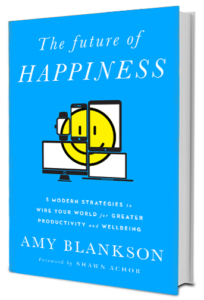How to Be Happy in the Digital Age
We live in the digital age.
Some bemoan the constant interruptions and endless internet surfing. Others celebrate the new-found freedom and capabilities.
How has the digital age impacted our happiness?
Amy Blankson is one of the world’s leading experts on the connection between positive psychology and technology. She is the only person to be named a Point of Light by two presidents (President George Bush Sr. and President Bill Clinton) for creating a movement to activate positive culture change. A sought-after speaker and consultant, Amy has now worked with organizations like Google, NASA, the US Army, and the Xprize Foundation to help foster a sense of well-being in the Digital Era.
Her new book, The Future of Happiness: 5 Modern Strategies for Balancing Productivity and Well-Being in the digital Era, is a blend of research, case studies, and practical tips to improve your happiness, productivity and health in the midst of the onslaught of apps, devices, and constant connection.
I recently spoke to her about staying positive in the midst of it all.
Happiness in the Digital Age
I want to start with the question that an entrepreneur asked you at one of your presentations: “Social media and technology are destroying our happiness, right?”
In recent months, I have seen a growing number of posts about how bad technology is for us. Technology is blamed for social isolation, disconnection, and corruption. But I’ve also heard and seen how technology can be used for good — a means to connect, to share knowledge, to empower, even to save lives. So, which is it: Is technology good for us or bad for us? Does technology make us less happy or more happy? As Shakespeare once said, “There is nothing either good or bad, but thinking makes it so.” Technology is a tool, a means to an end–and WE get to decide how that story ends.
Since technology can both bring joy and destroy it, tell us a few ways you’ve used it to your advantage. And tell us about what apps you’re using for happiness, productivity, and to “tune in, not zone out.”
One of my favorite examples of “happytech” is the Spire stone. The Spire stone is a small wearable that clips onto your bra strap or waistband to monitor your respiration and, in turn, lower blood pressure, reduce stress, and increase the flow of endorphins in your blood stream. The Spire uses your breathing patterns to figure out when you are tense, calm, or focused, and provides gentle notifications to guide you when you need it most.
When I first started testing out the Spire stone, I had a particularly poignant experience. Last spring, my family jumped into our backyard pool to enjoy the unseasonably warm weather. In an unfortunate turn of circumstances, my younger daughter jumped into the pool a bit too close to her older sister, landing on her neck and breaking her neck. I happened to be out of town when this happened, so I didn’t know how bad the situation was until I returned home and took my older daughter to the doctor. I was wearing my Spire stone the whole time and had managed to stay fairly calm through the doctor visit; however, as I was walking out of the hospital with my daughter in a giant neck brace, my Spire stone began to vibrate to let me know I was feeling tense. Pausing to think about what was going on, I realized that I was actually anxious about how other people would perceive me as the mother of a child with a broken neck. The nudge was just enough to help me reframe my thoughts to be more present for my daughter rather than worried about myself, and I was able to short-circuit an emotional response that might have taken me a week or more to realize before I had the Spire stone.
Tell us about the Happiness Cliff.
Sometimes tech is fun just for the sake of the endorphin rush and the dopamine boost. But at what point do those focus-altering diversions cause us to lose sight over what we really care about? At what point do diversions turn into fixations that are distracting?
Sometimes we become so engrossed in our diversions that we don’t notice that they are no longer making us happy anymore. Like Wile E. Coyote in Looney Tunes, we get our legs going so fast that it actually takes us a moment to realize that we have run right off the Happiness Cliff. Let me assure you that this never turns out well for poor Wile E.
According to the Law of Diminishing Returns, many diversions can actually be beneficial for our productivity and happiness—up to a point. Beyond that point, the diversion simply becomes a waste of time and eventually a time suck that becomes harmful to our productivity. To avoid falling off the happiness cliff, start your day by setting your intention for how you want to use your time. When you start to find yourself engrossed in a task, pause to ask if your technology use is helping you tune in (helping you to achieve your intention) or causing you to zone out. If your answer is the latter, then try to set a time limit for yourself to engage in that activity so that you don’t get sucked in and lose focus.
Train Your Brain to Be Positive
What does the latest research tell us about our ability to train our brains to be more positive?
The latest research from the field of positive psychology reveals that training our brains to be more positive is not only possible, it’s actually essential to striving after your full potential. Why? Because when your brain is positive, it receives a boost of dopamine, which turns on the learning centers in the brain and makes you able to see more possibilities in your environment. In fact, a positive brain has been linked to: 37% higher sales, 3x more creativity, 31% higher productivity, 40% increase in likelihood of receiving a promotion, 23% decrease in symptoms of fatigue, 10x increase in the level of engagement at work, a 39% increase in the likelihood of living to age 94, and a 50% decrease in the risk of heart disease.
Create a Habitat for Happiness
 I love your section about creating a habitat for happiness. Would you share just a few strategies from the book to make this a reality?
I love your section about creating a habitat for happiness. Would you share just a few strategies from the book to make this a reality?
Thanks to technology, we’ve become globalized, transient beings unbounded by the usual constraints of place and space. Some people work in offices, while others work from home, co-working spaces, or even coffee shops. We move fluidly in and out of a nebulous internet-based “cloud,” with half of our belongings in the physical world and the other half in some virtual world. As the places that we live, work, and learn become increasingly blurred, we have to reconceptualize what happiness looks like in the modern era. Here are a few strategies that I talk about in the book:
- Clear out physical clutter to make space for incoming technology: We harbor “tech graveyards” in our houses because we don’t know what to do with our expensive, unused relics. Check out e-stewards.org to learn about some great options for recycling and upcycling old tech.
- Clear out digital clutter to help eliminate distractions: Unsubscribe from the unnecessary in your life. Use services like unroll.me to help you quickly manage your inbox and then turn off as many notifications as you can on your phone and computer to limit distraction.
- Bring meaning back into the office: Many individuals make the mistake of just trying to slog through work until they can get home to their “real life.” However, research is revealing that investing in your personal space at work is beneficial to your happiness and health, and it can also increase your productivity by 15 percent. Amy Wrzesniewski, an associate professor of organizational behavior at Yale University’s School of Management, found that individuals who connect to their work on a deeper level are more satisfied in general with their work and their lives. Whether you have a cubicle or a shared space, take the time to find little ways to connect your home life with your work life, whether through photos and art on the walls or something more transportable like a day planner. For an extra boost, bring a plant to work to lower stress, reduce blood pressure, and feel more attentive.
- Set invisible boundaries to guard your focus and quality time: The average smartphone user opens and closes their phone 150 times a day. If it takes one minute to check your phone each time, that takes up 2.5 hours of your day! It’s time to get this habit under control. Download the Break Free app to see just how often you open and close your phone every day, and then use a distraction-free timer to try to get your phone addiction and email checking under control.
How does becoming a conscious innovator and contributing to collective knowledge fit into improving our happiness?
Often, we think of happiness as a solo pursuit. We understand that happiness is a personal choice and is something that takes diligence and effort to cultivate. However, if we stop the conversation there, we are missing out on the bigger picture. Neuroscience has taught us that we are all wirelessly connected through mirror neurons in the brain, enabling our minds to transmit emotion at lightning speed across a room. Mirror neurons explain how yawns and smiles can ripple across a room in under two minutes, but also how stress and negativity can spread as well. Knowing this, we can’t think about personal happiness in a vacuum. We each play an important role in shaping collective happiness, and we each have unique skills and talents to bring that vision to life. In my book, I encourage everyone to be a conscious innovator–this doesn’t mean that you have to be an inventor or an engineer or a coder; rather it’s an invitation for you to bring your experience and ideas into a broader conversation about where we as a society are heading. Rather than waiting for other people to “fix things,” I encourage readers to be creative about solving problems. The Digital Era offers some amazing new ways to brainstorm and collaborate (through crowdsourcing, open sourcing, upsourcing and more), so let’s use these resources to solve problems that we have never been able to solve before on our own.
Do you feel inordinate pressure to always be positive and upbeat around everyone who knows what you do?
I come from a family of happiness researchers, so yes, I think that people have expectations that I am always happy (not true). While I do like to smile a lot, my husband would be the first to tell you that this rosy image does not always fit my morning personality (at least, until I have my coffee)!
I do try to live out the principles that I espouse, but I’ve also had my struggles, such as when my husband and I were displaced and separated for about nine months due to Hurricane Katrina. I’ve learned that, even though external circumstances can be seriously challenging, 90% of our happiness is actually due to our perception of the world. So, when I find myself starting to become more negative or anxious, I can fall back on some of the research about rethinking stress to help reframe my mindset and short circuit my thought process. That being said, I’m a big believer in growth mindset–a state of mind in which we can constantly learn and grow–and I know I have a lot more to learn about staying positive in the face of challenges. I’m fortunate enough to be on the receiving end of stories that readers submit on the GoodThink website about how they have put this research to life, and I am continually inspired by them.
For more information, visit: The Future of Happiness: 5 Modern Strategies for Balancing Productivity and Well-Being in the digital Era

